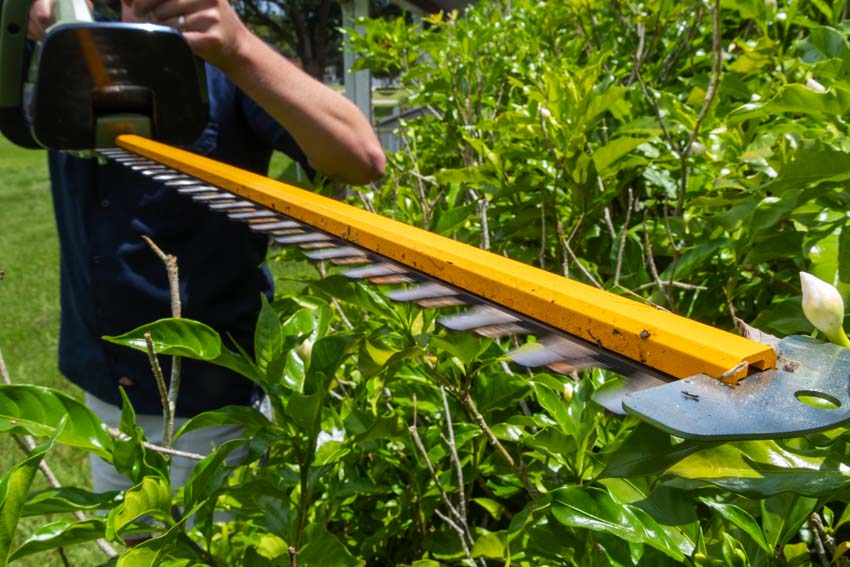Just like a well-manicured lawn requires a good lawnmower, you need a good hedge trimmer to maintain neat and tidy hedges. Explore the different types of hedge trimmers and how to use them effectively.
What are Hedge Trimmers?
Hedge trimmers are gardening tools that cut hedges. They have a long cutting bar powered by gas, electricity, or batteries. As the cutting bar moves back and forth along the toothed blade, it evenly cuts the branches of shrubs to create a neat, tidy hedge.
Hedge trimmers aren’t just for trimming hedges, although that’s their primary purpose. You can also use them to cut brush, knock back overgrown weeds, and clear brushy areas in your yard.
There’s a lot to know about hedge trimmers before you buy. In this comprehensive guide, you’ll discover everything you need to know to make an informed purchasing decision.
Types of Hedge Trimmers
How do you find the best hedge trimmer for your yard? First, take a look at the three basic types of hedge trimmers, how they are used, and the benefits of each type.
Electric Hedge Trimmers
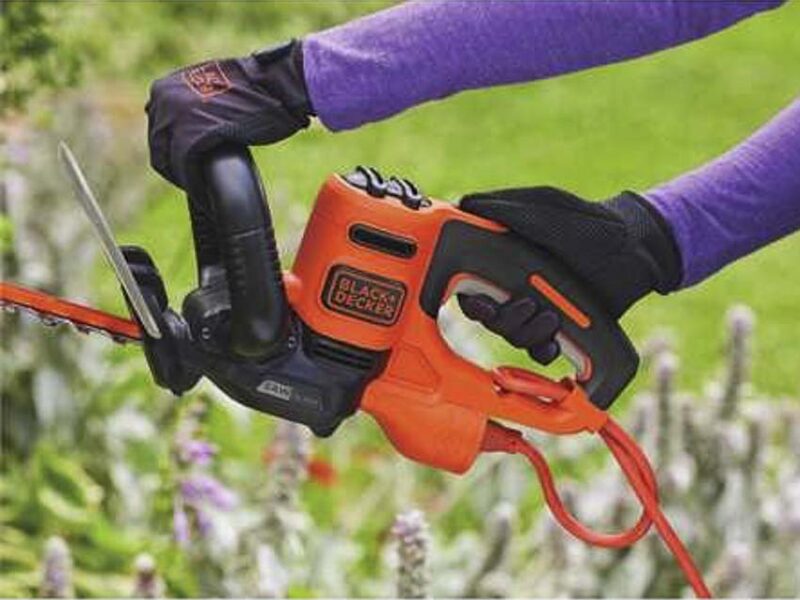
Electric hedge trimmers require an outlet and an extension cord to operate. They also tend to be the least expensive option. You don’t have to deal with messy refueling and never have to worry about running out of gas.
Corded-electric hedge trimmers are quieter than gas-powered models, but on the downside, they aren’t as powerful as gas-engine trimmers.
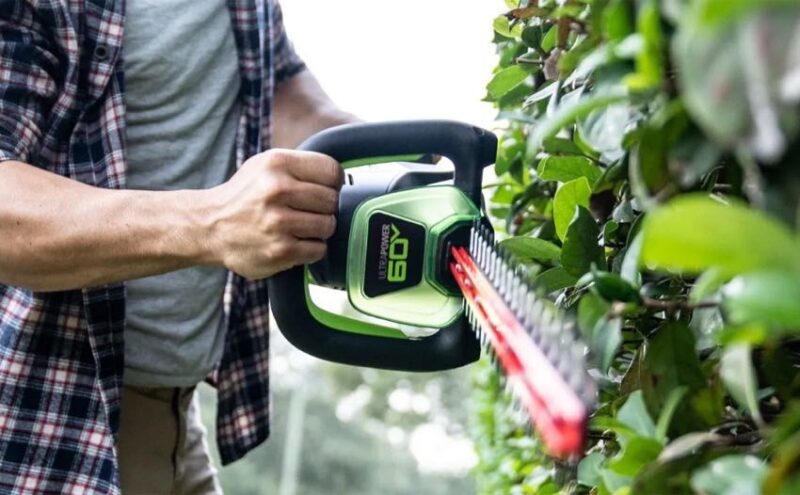
Another advantage of electric trimmers is that they are lightweight. Since you usually have to hold hedge trimmers at odd angles for long periods, being light benefits many people.
The average cost of an electric hedge trimmer is about $60 to $150, but if you don’t already have an extension cord rated for this product, don’t forget to factor that into the overall cost.
As with all electric power tools, cord length will limit you. If your hedges are far away, you will need a 16-gauge power cord that’s at least 100 feet long.
Cordless Hedge Trimmers
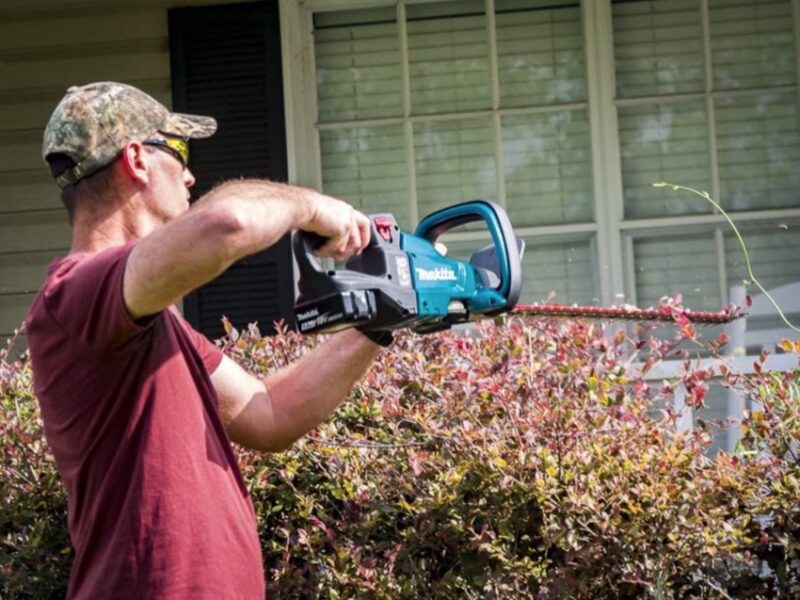
Battery-powered hedge trimmers have no cord to limit you or get in the way, and you also don’t have to deal with messy and smelly gas mixes.
Battery-powered tools have made significant advancements in the last decade, and many pack almost as much power as gas-powered models. A battery-powered hedge trimmer that lasts up to 2 hours on a single charge is adequate for the average homeowner.
Check out Ryobi’s 18V 24-inch cordless hedge trimmer!
One bonus with cordless hedge trimmers is that there are no emissions, so they are more environmentally friendly. However, they need more power for more difficult tasks, like clearing brush from your property or cutting thick branches.
Depending on the brand, a cordless hedge trimmer costs about $60 to $200. You can save money by purchasing a battery-powered trimmer if you own batteries for other power tools in the same brand lineup.
Gas-Powered Hedge Trimmers
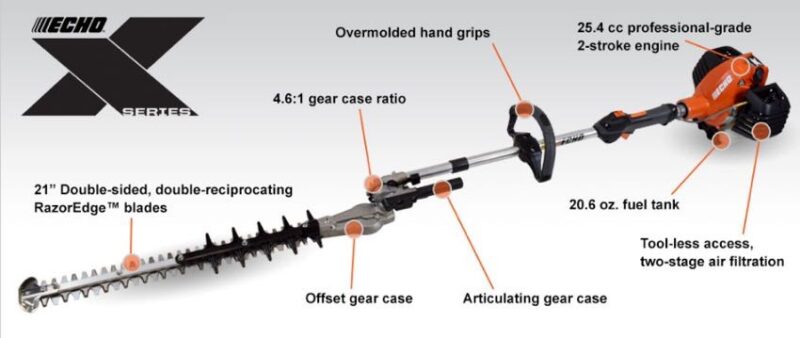
Gas-powered hedge trimmers are the best types for high power and long run times. They are the best option if you need the flexibility to reach hedges far away from your house and other electrical outlets.
Gas-powered hedge trimmers, like Echo hedge trimmers, are ideal for the toughest tasks, including clearing heavy brush and cutting branches up to 1 inch thick. Stihl hedge trimmers are another common brand.
Although heavy and less easy to maneuver than their lightweight counterparts, gas-powered hedge trimmers are often the top choice for professional landscapers.
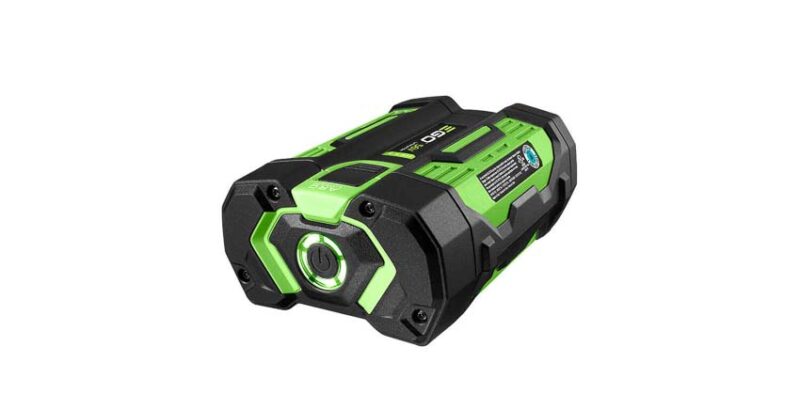
One disadvantage of gas-powered hedge trimmers is that they require more maintenance. You need to winterize them before you put them away at the end of the year, and they may require frequent tune-ups to stay running properly.
Want to know more about converting from gas- to battery-powered lawn equipment? OPE Reviews can help!
Hedge Trimmer Features
Consider the following features when shopping for the best backyard hedge trimmer.
Blade Type
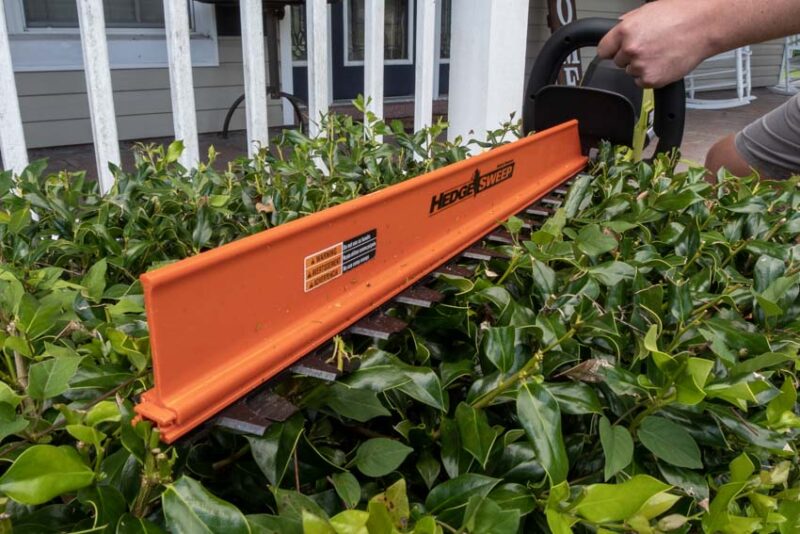
After the tool’s fuel source, the type of blade is one of the most important features to look for on hedge trimmers. Choose between single or double-action hedge trimmers, depending on the task at hand.
The difference between single and double-action hedge trimmers is that single-action blades have one stationary blade and one that moves. With double-action trimmers, both blades move against each other.
The advantage of single-action hedge trimmers is that the blades can be longer and better for wide hedges. They are also less expensive and easier to maintain.
Double-action hedge trimmers have reduced vibration and are better at cutting. Although they’re preferable, they often cost more than single-action trimmers. They are also easier for left-handed people to operate.
Blade Length
Most hedge trimmers have blades anywhere from 13 inches to 40 inches long, with some of the tiniest models having blades as short as five inches. You can also find super long blades up to 48 inches.
Here are some common blade lengths for hedge trimmers:
| Hedge trimmer blade length | Best for |
| 16 inches or less | Small- to medium-sized hedges |
| 18 inches | Average-sized hedges |
| 20 inches and up | Large hedges with thick branches |
Blade Teeth Spacing
Hedge trimmers have various teeth spacing, which determines the thickness of the material that the trimmer can cut. Blade teeth spacing gaps typically range from 0.5 inches to 1.5 inches.
Weight
Corded-electric hedge trimmers are the most lightweight models you can buy. Some weigh less than four pounds, so they are light enough for anyone to use.
Gas-powered hedge trimmers are much heavier, at about 10 to 12 pounds. Because they have more power, they can have longer blades, and the fuel tank and engine contribute extra weight.
Safety Features
One thing to consider is that if your hedge trimmer is too heavy for you, it will be less safe to operate. There are many other built-in features to look for on hedge trimmers:
- Tooth extensions that prevent contact and minimize the chances of getting cut.
- Dual switches for safer two-handed operation.
- Trigger switches that cut power to the blades as soon as the trigger is released.
- Lock buttons that protect small children by preventing accidental activation.
- Front handle shields and blade guards to prevent accidents.
Exploring the Benefits of Hedge Trimmers
Hedge trimmers are essential for tidy landscaping, especially if you have a formal garden, or you prefer a neat hedge. If you’re on the fence about whether to get a hedge trimmer, learn more about the benefits to decide if it’s a tool you need for your yard.
Neat and Tidy Landscaping

While some yard enthusiasts like a sprawling, wild garden, others prefer a neat and tidy landscape with well-manicured shrubs and hedges. With a hedge trimmer, you can create different formal-shaped hedges and trim your shrubs to any shape.
Use your hedge trimmer to create neat lines and edges in your landscape designs, from square-shaped shrubs to spherical bushes and topiaries. It’s the best way to add visual interest or achieve a formal look for your garden.
Efficient and Time-Saving
Many homeowners use pruners or shears to manually trim and prune the branches of the shrubs in their yards. But when you actually use one of the many types of hedge trimmers, it takes minimal effort to maintain your shrubs, and you can save time trimming and shaping all of your landscaping.
Hedge trimmers make it easy to maintain any size of hedge, and they also work great for trimming shrubs that are growing wild and unchecked.
You can also use hedge trimmers to clear undergrowth at the edges of your property, which can help get rid of ticks, fleas, and other pests in your yard.
Health of Plants
Shrubs require regular pruning to eliminate dead or overgrown branches. Proper pruning methods help stimulate new growth, resulting in a healthier hedge or shrub.
It’s possible to over-prune your hedges, but you should cut back most shrubs at least once or twice a year to maintain a healthy growth habit. Avoid cutting back more than one-third of a shrub or tree during a pruning session.
How to Use Hedge Trimmers Effectively
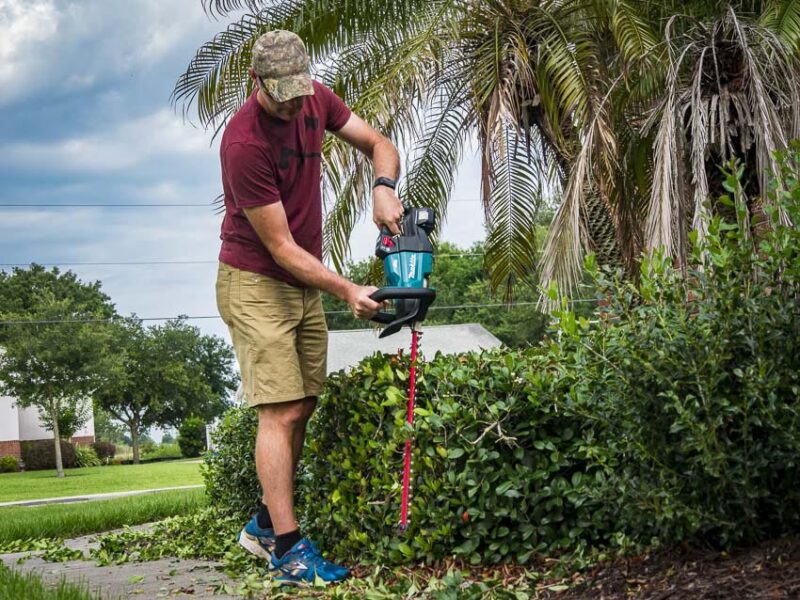
What’s the best way to use a hedge trimmer? Follow these tips and safety precautions to get the most out of your hedge trimmer.
Safety Precautions
Like many landscaping power tools and equipment, hedge trimmers can be dangerous. Many of them have built-in safety features that protect you from common accidents, but you should take the following safety precautions to ensure your personal safety:
- Always read the owner’s manual and follow the manufacturer’s instructions.
- Use extra caution when working in hard-to-reach areas.
- Keep two hands on the trimmer when it’s running.
- Keep at least 10 feet between you and other people or pets.
- Wear proper footwear, long pants, and long-sleeved shirts.
- Wear leather gloves to protect your fingers.
- Use eye and ear protection.
- Keep long hair in a ponytail, and don’t operate while wearing loose jewelry.
- Pay close attention to the cord when using electric hedge trimmers.
Trimming Techniques
Trimming hedges is simple and doesn’t require much explaining, but these steps will give good results:
- Start low and work your way up.
- Don’t cut as much underneath.
- Work your way around the sides.
- Then, finish off the top.
Go slowly, taking off a little bit at a time. You can always take off more, but you can’t put it back.
Shaping and Pruning
Shaping a bush into a ball requires more finesse than an aggressive trim. The best technique is to use natural gentle pruning or light trims with soft cuts, but you can also use a hedge trimmer to make aggressive cuts and shape your bush effectively.
Visualize the shape you want, and after making a couple of cuts, take a step back and assess the appearance of your shrub. Continue to trim the shrub until it’s the shape you want.
Maintenance and Cleaning
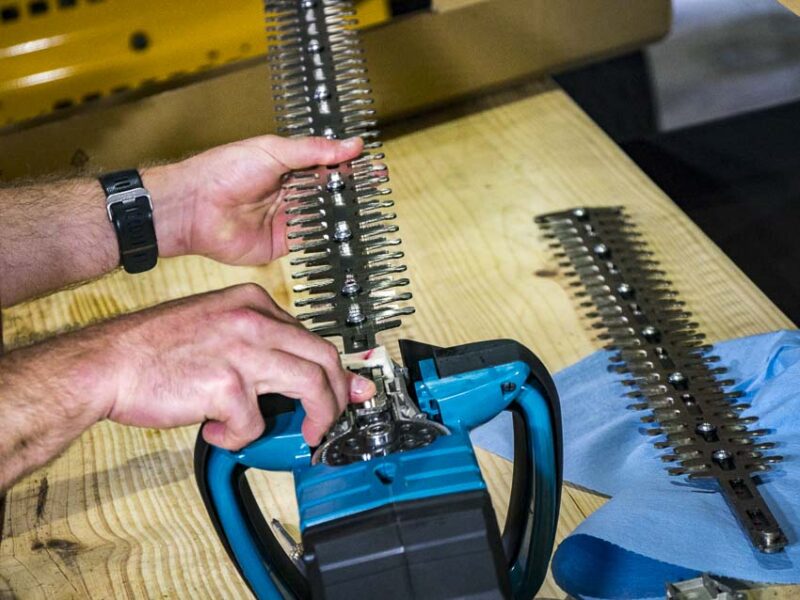
Your hedge trimmer will last many years with the proper care. After use and with the power off and the machine unplugged, clean the blades with a soapy rag, wipe dry with a clean cloth, and apply lubricant.
Remove the air filter and tap it to clean it. You may need to replace it, but don’t wash it unless your owner’s manual states you can.
Hedge trimmers also require sharpening, like most cutting tools. The easiest way to sharpen your hedge trimmer is with a cone-shaped bit in your drill, but you can also use a regular flat file.
Did you know that brushless electric motors are more efficient? Let us give you the 411 on brushless vs. brushed motor technology.
FAQ: Common Questions About Hedge Trimmers
1. Can I use hedge trimmers for other types of plants?
Hedge trimmers are designed to trim and shape hedges, but you can use them with other plants, as well. They may not be the best tool for the job, but using a hedge trimmer to cut tree branches and knock down large weeds is effective and doesn’t hurt your hedge trimmer. They will also work on overgrown grass.
2. How often should I trim my hedges?
Not all hedges grow at the same rate, but most shrubs only need to be cut once or twice a year. One cutting per year is adequate for informal hedges, and many formal hedges only need to be trimmed two times each growing season. Some fast-growing conifers may need more frequent trimming.
3. Are cordless hedge trimmers as powerful as gas-powered ones?
Generally speaking, cordless tools aren’t as powerful as gas-engine tools, and it’s also true with hedge trimmers. As an advantage, cordless tools are easier to maintain, but they usually only operate for one to two hours on a single battery charge.
4. Can I trim hedges in any season?
The best time to prune hedges is when they are dormant. They go dormant in the fall and come out of dormancy in the spring when they start to leaf out. The worst thing you can do for hedges is to prune them during the hottest part of the summer.
5. Is it possible to over-trim hedges?
With most shrubs, using the one-third rule when pruning is best. This means you should never prune back more than one-third of a shrub’s growth at any one pruning.

